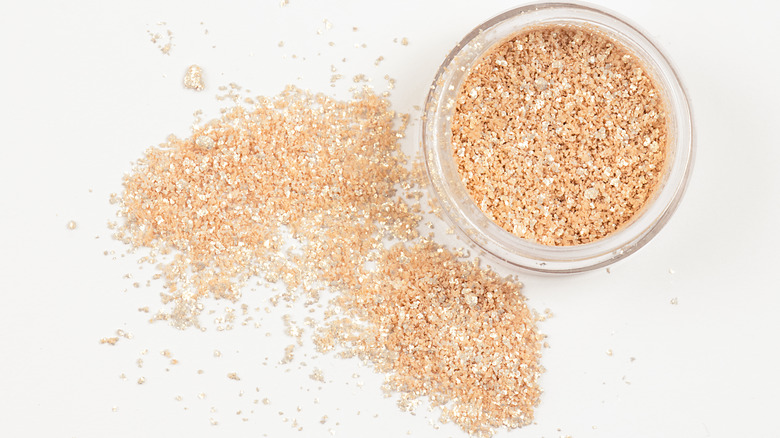You Should Think Twice Before Baking With This Ingredient
Baking isn't just about making delectable desserts. For many, it's a work of art. With food pics and videos being some of the most popular forms of social and streaming content, bakers are looking for new ways to dazzle their audiences. This includes the recent and very popular luster dust trend, in which bakers dust taste-free decorative powder over the tops of their confections and baked goods to give them a shimmery effect (via The Spruce Eats).
Unfortunately, not all luster dust is edible, and some consumers are accidentally ingesting toxic heavy metals which can pose serious health risks. In 2018, investigators in Rhode Island discovered cases of heavy metal poisoning (high levels of copper, lead, and other metals) linked to children eating birthday cakes decorated with luster dust (via U.S. News and World Report). Some children were hospitalized; others suffered from vomiting and diarrhea. The cake came from a local bakery that mixed heavy-metal-laden luster dust into the frosting.
Food labeling and sourcing concerns
It's not surprising there have been cases of accidental ingestion. It appears that a great deal of confusion has stemmed from food label verbiage. Some labels state that the luster dust is nontoxic. But health experts warn that nontoxic doesn't mean it's edible, and unless the label says "food-grade" or "edible" and lists all the ingredients on the label, it shouldn't be eaten (per U.S. News and World Report).
In addition to general confusion over food labeling, there may also be an issue with food sourcing. In order to ensure a food item is safe for consumption, it's important to purchase edible food decorations from a reputable source. While online purchases can be more convenient, it's harder to know where the ingredients come from. It's not to say reputable online stores don't exist, but some online retailers have repackaged nonedible versions of luster dust and labeled them as being edible, according to The Spruce Eats.
Children have the greatest health risks
While any age range can experience negative health impacts from ingesting heavy metals, young children seem to carry the greatest health risks. For instance, when it comes to lead, children younger than six years old have a higher risk of developing health issues due to the fact that their bodies absorb the heavy metal more easily, explains Kids Health. Additionally, if heavy metal poisoning in children isn't treated early, it can pose serious health risks including brain and nervous system damage, learning problems, headaches, seizures, aggression, and ongoing stomach pain (via Cedars Sinai).
While lead exposure may cause symptoms, sometimes it can go undetected. Therefore, ongoing testing should help monitor your child's risks. While COVID-19 resulted in fewer children getting tested for lead exposure, health experts suggest it's important to ensure that lead testing is a part of their annual physical exam. If you suspect your child's been exposed, don't hesitate to contact your doctor right away.



